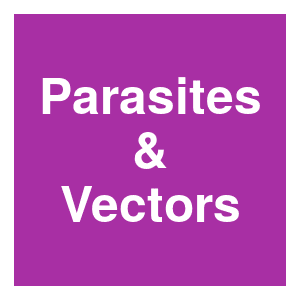
Keywords: Culex

|
A synthetic biology approach to transgene expressionP. Leftwich, T. , J. Purcell, C. , M. Anderson, A. E. , R. Fragkoudis, S. Basu, G. Lycett, T. and L. Alphey, bioRxiv, 2023.08.31.555539. 2023.
The ability to control gene expression is pivotal in genetic engineering and synthetic biology. However, in most non-model and pest insect species, empirical evidence for predictable modulation of gene expression levels is lacking. This knowledge gap is critical for genetic ... Keywords: Cas9, CRISPR, Culex, genetic biocontrol, quinquefasciatus, transgenic mosquitos |

|
Draft environmental assessment for use of Wolbachia-based incompatible insect technique for the suppression of nonnative southern house mosquito populations on KauaʻiHawai'i Department of Land and Natural Resources, Hawai'i Department of Land and Natural Resources, 2023.
The State of Hawai'i Department of Land and Natural Resources hereby transmits the Draft Environmental Assessment and Anticipated Finding of No Significant Impact (DEAEnvironmental Assessment for use of Wolbachia-based Incompatible Insect Technique for the suppression of ... Keywords: Cas9, CRISPR, Culex, genetic biocontrol, quinquefasciatus, transgenic mosquitos |

|
CRISPR-based gene drives generate super-Mendelian inheritance in the disease vector Culex quinquefasciatusT. Harvey-Samuel, X. Feng, E. M. Okamoto, D.-K. Purusothaman, P. T. Leftwich, L. Alphey and V. M. Gantz, bioRxiv, 2023.06.12.544656. 2023.
Culex mosquitoes pose a significant public health threat as vectors for a variety of diseases including West Nile virus and lymphatic filariasis, and transmit pathogens threatening livestock, companion animals, and endangered birds. Rampant insecticide resistance makes ... Keywords: Cas9, CRISPR, Culex, genetic biocontrol, quinquefasciatus, transgenic mosquitos |

|
A mass rearing cost calculator for the control of Culex quinquefasciatus in Hawaiʻi using the incompatible insect techniqueA. E. Vorsino and Z. Xi, Parasites and Vectors, 15:453. 2022.
Hawaiʻi’s native forest avifauna is experiencing drastic declines due to climate change-induced increases in temperature encroaching on their upper-elevation montane rainforest refugia. Higher temperatures support greater avian malaria infection rates due to greater densities ... Keywords: Cas9, CRISPR, Culex, genetic biocontrol, quinquefasciatus, transgenic mosquitos |

|
Mosquito control to save Hawaiian honeycreepers does not involve GMOsDepartment of Land and Natural Resources, Hawaii Department of Land and Natural Resources, 2022.
Despite misinformation circulating on social media, the importation of “incompatible-male” mosquitoes to control populations of wild mosquitoes and to save four native bird species from extinction, does not involve the use of any genetically modified organisms (GMOs) or ... Keywords: Cas9, CRISPR, Culex, genetic biocontrol, quinquefasciatus, transgenic mosquitos |

|
Paternal transmission of the Wolbachia CidB toxin underlies cytoplasmic incompatibilityB. Horard, K. Terretaz, A. S. Gosselin-Grenet, H. Sobry, M. Sicard, F. Landmann and B. Loppin, Current Biology, 2022.
Wolbachia are widespread endosymbiotic bacteria that manipulate the reproduction of arthropods through a diversity of cellular mechanisms. In cytoplasmic incompatibility (CI), a sterility syndrome originally discovered in the mosquito Culex pipiens, uninfected eggs fertilized by ... Keywords: Cas9, CRISPR, Culex, genetic biocontrol, quinquefasciatus, transgenic mosquitos |

|
Beyond the eye: Kynurenine pathway impairment causes midgut homeostasis dysfunction and survival and reproductive costs in blood-feeding mosquitoesV. Bottino-Rojas, I. Ferreira, R. D. Nunes, X. Feng, T. B. Pham, A. Kelsey, R. Carballar-Lejarazú, V. Gantz, P. L. Oliveira and A. A. James, Insect Biochemistry and Molecular Biology, 103720. 2022.
Insect ommochrome biosynthesis pathways metabolize tryptophan to generate eye-color pigments and naturally occurring alleles of pathway genes are useful phenotypic markers in transgenesis studies. Pleiotropic effects of mutations in some genes exert a load on both survival and ... Keywords: Cas9, CRISPR, Culex, genetic biocontrol, quinquefasciatus, transgenic mosquitos |

|
Wolbachia Endosymbiont and Mosquito Vectors, with Emphasis on Lymphatic Filariasis EliminationI. P. Sunish, Genetically Modified and other Innovative Vector Control Technologies, 2021.
Wolbachia are maternally inherited intracellular bacteria, known to alter early development and mitotic processes in their hosts. They are frequently observed as a reproductive parasite, capable of inducing feminization, parthenogenesis, male killing, or cytoplasmic ... Keywords: Cas9, CRISPR, Culex, genetic biocontrol, quinquefasciatus, transgenic mosquitos |

|
Prevalence and molecular characterization of Wolbachia in field-collected Aedes albopictus, Anopheles sinensis, Armigeres subalbatus, Culex pipiens and Cx. tritaeniorhynchus in ChinaY. Yang, Y. He, G. Zhu, J. Zhang, Z. Gong, S. Huang, G. Lu, Y. Peng, Y. Meng, X. Hao, C. Wang, J. Sun and S. Shang, PLOS Neglected Tropical Diseases, 15:e0009911. 2021.
Wolbachia are maternally transmitted intracellular bacteria that can naturally and artificially infect arthropods and nematodes. Recently, they were applied to control the spread of mosquito-borne pathogens by causing cytoplasmic incompatibility (CI) between germ cells of females ... Keywords: Cas9, CRISPR, Culex, genetic biocontrol, quinquefasciatus, transgenic mosquitos |

|
Scientists use gene editing tool to target mosquito-spread diseaseMedical Research Council, Phys Org, 2021.
Advances in genome editing have allowed the development of genetic insect control methods, which could be highly effective and are species-specific. The results have been published in Scientific Reports. Scientists showed that a method involving a gene editing tool called ... Keywords: Cas9, CRISPR, Culex, genetic biocontrol, quinquefasciatus, transgenic mosquitos |

|
CRISPR/Cas-9 mediated knock-in by homology dependent repair in the West Nile Virus vector Culex quinquefasciatus SayD.-K. Purusothaman, L. Shackleford, M. A. E. Anderson, T. Harvey-Samuel and L. Alphey, Scientific Reports, 11:14964. 2021.
Culex quinquefasciatus Say is a mosquito distributed in both tropical and subtropical regions of the world. It is a night-active, opportunistic blood-feeder and vectors many animal and human diseases, including West Nile Virus and avian malaria. Current vector control methods ... Keywords: Cas9, CRISPR, Culex, genetic biocontrol, quinquefasciatus, transgenic mosquitos |

|
Optimized CRISPR tools and site-directed transgenesis in Culex quinquefasciatus mosquitoes for gene drive developmentX. Feng, V. Lopez Del Amo, E. Mameli, M. Lee, A. L. Bishop, N. Perrimon and V. M. Gantz, bioRxiv, 2021.02.10.430702. 2021.
Here, we developed a Culex-specific Cas9/gRNA expression toolkit and used site-directed homology-based transgenesis to generate and validate a Culex quinquefasciatus Cas9-expressing line. We showed that gRNA scaffold variants improve transgenesis efficiency in both Culex and ... Keywords: Cas9, CRISPR, Culex, genetic biocontrol, quinquefasciatus, transgenic mosquitos |

|
Targeting female flight for genetic control of mosquitoesD. Navarro-Payá, I. Flis, M. A. E. Anderson, P. Hawes, M. Li, O. S. Akbari, S. Basu and L. Alphey, PLOS Neglected Tropical Diseases, 14:e0008876. 2020.
The yellow fever mosquito and the Southern house mosquito are important vectors of infectious diseases. Given their widespread presence across tropical and subtropical regions of the world and the increased risk of spread due to global warming there is a growing need for ... Keywords: Cas9, CRISPR, Culex, genetic biocontrol, quinquefasciatus, transgenic mosquitos |

|
Cytoplasmic incompatibility: an autocidal mechanism for mosquito population controlV. Dev, BugBitten BMC, 2020.
Cytoplasmic incompatibility resulting in non-reciprocal fertility is a naturally occurring phenomenon, but remains unexplored to greater extent for the control of insect vector populations. This mechanism deserves priority for mosquito control and reducing disease transmission, ... Keywords: Cas9, CRISPR, Culex, genetic biocontrol, quinquefasciatus, transgenic mosquitos |

|
Research team genetically modifies mosquito; now completing construction of full gene drive systemUniversity of Hawaii, UH Hilo News, 2020.
A research group at the University of Hawai‘i at Hilo is currently completing construction of the full gene drive system of the Hawai‘i-sourced southern house mosquito (Culex quinquefasciatus), and plan to use CRISPR technology to insert it alongside an eye-color phenotype ... Keywords: Cas9, CRISPR, Culex, genetic biocontrol, quinquefasciatus, transgenic mosquitos |

|
Wolbachia and cytoplasmic incompatibility in mosquitoesSinkins, SP, Insect Biochemistry and Molecular Biology, 34:723-729. 2004.
Wolbachia are maternally inherited bacteria that induce cytoplasmic incompatibility in mosquitoes, and are able to use these patterns of sterility to spread themselves through populations. For this reason they have been proposed as a gene drive system for mosquito genetic ... Keywords: Cas9, CRISPR, Culex, genetic biocontrol, quinquefasciatus, transgenic mosquitos |

|
Population replacement in Culex-fatigans by means of cytoplasmic incompatibility .2. Field cage experiments with overlapping generationsC. F. Curtis, Bulletin of the World Health Organization, 53:107-119. 1976.
Three experiments were carried out in field cages to test the principle of " transport" of a desirable gene or chromosome into a wild Culex fatigans population as a result of the sterility in cross-matings associated with cytoplasmic incompatibility. Cycling populations of Delhi ... Keywords: Cas9, CRISPR, Culex, genetic biocontrol, quinquefasciatus, transgenic mosquitos |

|
Population replacement in Culex fatigens by means of cytoplasmic incompatibility. Laboratory experiments with non-overlapping generationsC. F. Curtis and T. Adak, Bulletin of the World Health Organization, 51:249-255. 1974.
Bidirectional cytoplasmic incompatibility in the Culex pipiens complex appears to provide a mechanism for the replacement of a wild population by a strain refractory to filaria or a strain made partly sterile by a translocation. As a preliminary test of the feasibility of the ... Keywords: Cas9, CRISPR, Culex, genetic biocontrol, quinquefasciatus, transgenic mosquitos |

|
Eradication of Culex pipiens fatigans through cytoplasmic incompatibility.H. Laven, Nature, 216:383. 1967.
Culex pipiens fatigans is the chief vector of filariasis in south-east Asia. Urbanization has often caused the numbers of this mosquito-and with it the danger of filariasis infection-to increase alarmingly. The natural vigour, tolerance and fast development of resistance to ... Keywords: Cas9, CRISPR, Culex, genetic biocontrol, quinquefasciatus, transgenic mosquitos |

Contact
David O’Brochta
Foundation for the
National Institutes of Health
geneconvenevi@fnih.org
RSS

